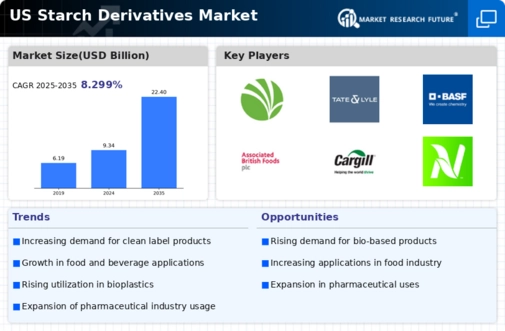Growing Health Consciousness
The increasing awareness of health and nutrition among consumers is driving the starch derivatives market. As individuals seek healthier food options, the demand for natural and functional ingredients rises. Starch derivatives, known for their thickening, gelling, and stabilizing properties, are increasingly utilized in low-calorie and gluten-free products. In the US, the health food sector has expanded significantly, with sales reaching approximately $200 billion in 2025. This trend suggests that manufacturers are likely to incorporate starch derivatives to enhance the nutritional profile of their offerings, thereby boosting the market. The starch derivatives market is poised to benefit from this shift as consumers prioritize health and wellness in their dietary choices.
Expansion of Processed Food Sector
The processed food sector in the US is experiencing robust growth, which is positively impacting the starch derivatives market. With a projected market value of $1 trillion by 2025, the demand for starch derivatives as functional ingredients in processed foods is likely to increase. These derivatives serve various purposes, including improving texture, extending shelf life, and enhancing flavor. As food manufacturers strive to meet consumer preferences for convenience and quality, the incorporation of starch derivatives becomes essential. The starch derivatives market is thus positioned to capitalize on this expansion, as more companies seek to innovate and differentiate their products in a competitive landscape.
Technological Innovations in Processing
Advancements in processing technologies are transforming the starch derivatives market. Innovations such as enzymatic modification and extrusion techniques are enhancing the functionality and versatility of starch derivatives. These technologies enable manufacturers to produce customized products that meet specific consumer needs, such as improved solubility and stability. The US starch derivatives market is likely to benefit from these developments, as companies adopt new methods to enhance product quality and performance. As a result, the market may witness an influx of innovative applications across various sectors, including food, pharmaceuticals, and personal care.
Rising Demand for Biodegradable Products
The growing emphasis on sustainability and environmental responsibility is influencing the starch derivatives market. As consumers and businesses alike seek biodegradable alternatives to synthetic materials, starch derivatives are emerging as viable options. These natural polymers can be utilized in packaging, disposable utensils, and other applications, aligning with the increasing demand for eco-friendly products. The US biodegradable plastics market is projected to reach $5 billion by 2025, indicating a significant opportunity for the starch derivatives market. This trend suggests that manufacturers may increasingly invest in research and development to create innovative biodegradable solutions, further driving market growth.
Increased Investment in Research and Development
Investment in research and development (R&D) within the starch derivatives market is on the rise, driven by the need for innovation and product differentiation. Companies are focusing on developing new starch derivatives with enhanced properties to cater to diverse applications. In the US, R&D spending in the food and beverage sector is expected to exceed $10 billion by 2025, indicating a strong commitment to innovation. This trend suggests that the starch derivatives market will likely see a surge in new product launches and formulations, as manufacturers strive to meet evolving consumer demands and regulatory standards.




















Leave a Comment